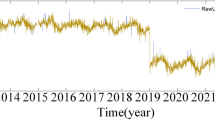Abstract
Previous studies have proved that commercial, off-the-shelf, geodetic-quality Global Positioning System (GPS) receivers can monitor water level using multipath interferometric characteristics from the sea surface. A Lomb–Scargle periodogram (LSP) is typically used to extract the multipath frequency from the signal-to-noise ratio (SNR), which relates to the vertical distance between the antenna phase center and the reflecting surface, and subsequently, estimate sea levels. A wavelet transform can be used to analyze the time series with a nonstationary power at different frequencies, as can be the case for multipath signals. In addition, wavelet transform analysis estimates the local energy and instantaneous frequency of the signal at every epoch, which is beneficial for water-level estimation. Therefore, we attempt to extract the instantaneous multipath frequency using wavelet transform analysis for water leveling with a geodetic GPS receiver. This study analyzed SNR data of GPS L1C from three test sites: the Kachemak Bay site PBAY (AK, USA), the Friday Harbor site SC02 (WA, USA), and the Brest Harbor site BRST (France). These sites are located in different multipath environments, from a rural coastal area to a busy harbor, and they experience different tidal regimes. The results show that the wavelet analysis has potential for the retrieval of sea level heights. For measurement site PBAY the comparison of the results obtained by the wavelet and LSP analysis yield consistency within a few percent. At the other two sites, SC02 and BRST, the agreement is significantly lower.











Similar content being viewed by others
References
Abry P (1997) Ondelettes et turbulence. Multirésolutions, algorithmes de décomposition, invariance d’échelles. Diderot Editeur, Paris
Anderson KD (2000) Determination of water level and tides using interferometric observations of GPS signals. J Atmos Ocean Technol 17(8):1118–1127. https://doi.org/10.1175/1520-0426(2000)017%3C1118:DOWLAT%3E2.0.CO;2
Bilich A, Larson KM (2007) Mapping the GPS multipath environment using the signal-to-noise ratio (SNR). Radio Sci 42:RS6003. https://doi.org/10.1029/2007RS003652
Bilich A, Larson KM (2008) Correction to: Mapping the GPS multipath environment using the signal-to-noise ratio (SNR). Radio Sci 43:RS2006. https://doi.org/10.1029/2008RS003839
Bilich A, Larson KM, Axelrad P (2008) Modeling GPS phase multipath with SNR: case study from the Salar de Uyuni, Bolivia. J Geophys Res 113:B04401. https://doi.org/10.1029/2007JB005194
Jin SG, Feng GP, Gleason S (2011) Remote sensing using GNSS signals: current status and future directions. Adv Space Res 47(10):1645–1653. https://doi.org/10.1016/j.asr.2011.01.036
Jin SG, Cardellach E, Xie F (2014) GNSS remote sensing: theory, methods and applications. Springer, Dordrecht
Jonscher AK (1981) A new understanding of the dielectric relaxation of solids. J Mater Sci 16(8):2037–2060
Larson KM, Nievinski FG (2013) GPS snow sensing: results from the EarthScope Plate Boundary Observatory. GPS Solut 17(1):41–52. https://doi.org/10.1007/s10291-012-0259-7
Larson KM, Small EE (2014) GPS ground networks for water cycle sensing. In: 2014 IEEE Geoscience and remote sensing symposium. IEEE, pp 3822–3825. https://doi.org/10.1109/IGARSS.2014.6947317 (ISBN 978-1-4799-5775-0)
Larson KM, Löfgren JS, Haas R (2013a) Coastal sea level measurements using a single geodetic GPS receiver. Adv Space Res 51(8):1301–1310. https://doi.org/10.1016/j.asr.2012.04.017
Larson KM, Ray RD, Nievinski FG, Freymueller JT (2013b) The accidental tide gauge: a GPS reflection case study from Kachemak Bay, Alaska. IEEE Geosci Remote Sens Lett 10(5):1200–1204. https://doi.org/10.1109/LGRS.2012.2236075
Larson KM, Ray RD, Williams S (2017) A ten-year comparison of water levels measured with a geodetic GPS receiver versus a conventional tide gauge. J Atmos Ocean Technol 34(2):295–307. https://doi.org/10.1175/JTECH-D-16-0101.1
Löfgren JS, Haas R (2014) Sea level measurements using multi-frequency GPS and GLONASS observations. EURASIP J Adv Signal Proc 2015:50. https://doi.org/10.1186/1687-6180-2014-50
Löfgren JS, Haas R, Scherneck HG (2014) Sea level time series and ocean tide analysis from multipath signals at five GPS sites in different parts of the world. J Geodyn 80:66–80. https://doi.org/10.1016/j.jog.2014.02.012
Martin Miguez B, Testut L, Woppelmann G (2008) The Van de Casteele test revisited: an efficient approach to tide gauge error characterization. J Atmos Ocean Technol 25(7):1238–1244. https://doi.org/10.1175/2007JTECHO554.1
Nievinski FG, Larson KM (2014) Forward modeling of GPS multipath for near-surface reflectometry and positioning applications. GPS Solut 18(2):309–322. https://doi.org/10.1007/s10291-013-0331-y
Pérez B, Payo A, López D, Woodworth PL, Fanjul A, E (2014) Overlapping sea level time series measured using different technologies: an example from the REDMAR Spanish network. Nat Hazards Earth Syst Sci 14:589–610. https://doi.org/10.5194/nhess-14-589-2014
Schöne T, Schön N, Thaller D (2009) IGS tide gauge benchmark monitoring pilot project (TIGA): scientific benefits. J Geod 83(3):249–261. https://doi.org/10.1007/s00190-008-0269-y
Strandberg J, Hobiger T, Haas R (2016) Improving GPS-R sea level determination through inverse modeling of SNR data. Radio Sci 51:1286–1296
Tabibi S, Geremia-Nievinski F, Dam TV (2017) Statistical comparison and combination of GPS, GLONASS, and multi-GNSS multipath reflectometry applied to snow depth retrieval. IEEE Trans Geosci Remote Sens 55(7):3773–3785. https://doi.org/10.1109/TGRS.2017.2679899
Torrence C, Compo GP (1998) A practical guide to wavelet analysis. Bull Am Meteorol Soc 79(1):61–78. https://doi.org/10.1175/1520-0477(1998)079%3C0061:APGTWA%3E2.0.CO;2
Wang X, Zhang Q, Zhang S (2018a) Water levels measured with SNR using wavelet decomposition and Lomb–Scargle periodogram. GPS Solut 22:22. https://doi.org/10.1007/s10291-017-0684-8
Wang X, Zhang Q, Zhang S (2018b) Azimuth selection for sea level measurements using geodetic GPS receivers. Adv Space Res. https://doi.org/10.1016/j.asr.2018.01.002
Werner G, Lou E (2009) RINEX (the receiver independent exchange format) version 3.01. ftp://igs.org/pub/data/format
Williams SDP, Nievinski FG (2017) Tropospheric delays in ground-based GNSS multipath reflectometry—experimental evidence from coastal sites. J Geophys Res Solid Earth 122:2310–2327. https://doi.org/10.1002/2016JB013612
Acknowledgements
GPS data of SC02 and PBAY sites were provided by the University NAVSTAR Consortium (UNAVCO; http://www.unavco.org/) and GPS data of BRST were provided by the International GNSS Service (IGS; http://www.igs.org). Friday Harbor and Seldovia tide gauge data were provided by the National Oceanic and Atmospheric Administration (NOAA; http://tidesandcurrents.noaa.gov/). Brest tide gauge data were provided by the Reseaux de Reference des Observations Maregraphiques (REFMAR; http://refmar.shom.fr/). We also acknowledge English language editing by Editage (http://www.editage.cn).
Author information
Authors and Affiliations
Corresponding authors
Rights and permissions
About this article
Cite this article
Wang, X., Zhang, Q. & Zhang, S. Sea level estimation from SNR data of geodetic receivers using wavelet analysis. GPS Solut 23, 6 (2019). https://doi.org/10.1007/s10291-018-0798-7
Received:
Accepted:
Published:
DOI: https://doi.org/10.1007/s10291-018-0798-7




